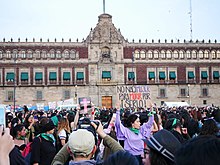This article is written like a personal reflection, personal essay, or argumentative essay that states a Wikipedia editor's personal feelings or presents an original argument about a topic. (July 2022) |

Mexico has one of the world's highest femicide rates,[1][2] with as many as 3% of murder victims being classified as femicides. In 2021, approximately 1,000 femicides took place, out of 34,000 total murder victims.[3] Ciudad Juárez, in Chihuahua, has one of the highest rates of femicide within the country. As of 2023, Colima State in Mexico has the highest rate of femicide, with over 4 out of every 100,000 women were murdered because of their gender. Morelos and Campeche were the following in terms of highest rates of femicide by 2023.[4]
Mexico is also among the leading country in term of murders, and 90% of the victims of murder are men. This escalation of violence began in the early 1990s and was followed by a wave of sexual violence and torture, abductions, increasing rates of women being murdered because of their gender.[5] While the number of women murdered in Mexico has grown substantially in recent years, the proportion of female victims of homicide has stayed constant over the last few decades. According to INEGI (Instituto Nacional de Estadística y Geografía), the ratio of homicides targeting women hovered between 10-13% from 1990 to 2020.
Up to one third of female murder victims in Mexico are murdered by their current or ex partners.[5] This violence has been attributed to the backlash theory, which alleges that as a marginalized group gains more rights within their society, there is a violent backlash from their oppressors.[1] Notably at a higher risk of gender based violence, like femicide, are Indigenous women due to economic marginalization, limited access to health and government protections, heightening their vulnerability.[6] Additionally, indigenous women make up 15% of the population, and with geographic isolation and gender inequality there are minimal methods of effective intervention and victim support.[7] The response from the Mexican government has been relatively minimal; there is very little legislation protecting women.[8] This lack of response further discourages individuals or groups from speaking out about or challenging this phenomenon.[2] Local police and government officials are known to dismiss instances of women going missing, and in some cases have been found to be in connection with various instances of violence against women.[2] There have been many small feminist movements which have attempted to bring attention to the level of violence that Mexican women face.[9] These movements primarily focus their efforts on demonstrations, sharing their own experiences, and creating works of art to express their frustrations.[2]

Mexico officially began documenting the amount of femicides in 2012.[10] In 2021, roughly 3% of murder victims (~1,000 out of 34,000 total) were classed as femicides. On average, ten girls or women and 100 boys and men are killed daily in Mexico; it is estimated three femicides take place each day.[10] The high murder rate in the country has continued to make international news, while directing attention to the abilities of Mexican authorities to deter crime and violence.[10]
- ^ a b Frías, Sonia (2021). "Femicide and Feminicide in Mexico: Patterns and Trends in Indigenous and Non-Indigenous Regions". Feminist Criminology. 18: 3–23. doi:10.1177/15570851211029377. S2CID 237766778.
- ^ a b c d Driver, Alice (2016-12-01). ""We Want to Stay Alive"". World Policy Journal. 33 (4): 39–46. doi:10.1215/07402775-3812949. ISSN 0740-2775. S2CID 157721799.
- ^ "Homicides in Mexico – Statistics". Vision of Humanity. 6 June 2022.
- ^ "States with the worst femicide rates in Mexico 2023". Statista. Retrieved 2024-09-28.
- ^ a b Ensalaco, Mark (May 2006). "Murder in Ciudad Juárez". Violence Against Women. 12 (5): 417–440. doi:10.1177/1077801206287963. ISSN 1077-8012. PMID 16617169. S2CID 19975572.
- ^ "Indigenous Women: The Invisible Victims of Femicide in Mexico". Harvard International Review. 2020-11-30. Retrieved 2024-11-01.
- ^ Frías, Sonia M. (January 2023). "Femicide and Feminicide in Mexico: Patterns and Trends in Indigenous and Non-Indigenous Regions". Feminist Criminology. 18 (1): 3–23. doi:10.1177/15570851211029377. ISSN 1557-0851.
- ^ Angulo Lopez, Geofredo (2019-06-13). "Femicide and Gender Violence in Mexico: Elements for a Systemic Approach". The Age of Human Rights Journal (12): 158–183. doi:10.17561/tahrj.n12.9. ISSN 2340-9592. S2CID 198747541.
- ^ Garza, Cristina Rivera (2020). "On Our Toes: Women against the Femicide Machine in Mexico". World Literature Today. 94 (1): 50–54. doi:10.1353/wlt.2020.0044. ISSN 1945-8134. S2CID 245660960.
- ^ a b c Sanchez, Fabiola; Pesce, Fernanda (27 December 2022). "Femicides in Mexico: Little Progress on Longstanding Issue". AP NEWS. Associated Press.
